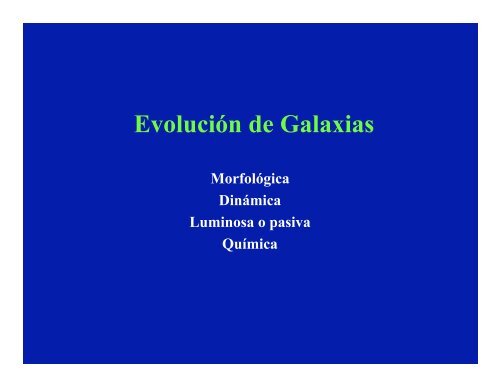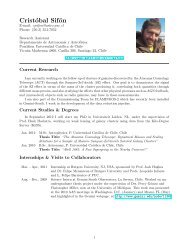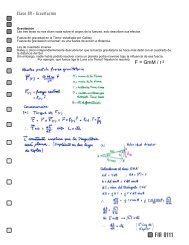Evolución de Galaxias
Evolución de Galaxias
Evolución de Galaxias
Create successful ePaper yourself
Turn your PDF publications into a flip-book with our unique Google optimized e-Paper software.
<strong>Evolución</strong> <strong>de</strong> <strong>Galaxias</strong><br />
Morfológica<br />
Dinámica<br />
Luminosa o pasiva<br />
Química
Hay cuatro tipos <strong>de</strong> evolución en las<br />
galaxias:<br />
– <strong>Evolución</strong> morfológica<br />
– <strong>Evolución</strong> dinámica<br />
– <strong>Evolución</strong> luminosa o pasiva<br />
– <strong>Evolución</strong> química
<strong>Evolución</strong> Morfológica<br />
La evolución morfológica <strong>de</strong>pen<strong>de</strong> <strong>de</strong> la tasa <strong>de</strong> colisiones<br />
entre galaxias. Esto hace que su estudio teórico sea<br />
difícil. Sin embargo, simulaciones <strong>de</strong> N cuerpos ha<br />
arrojado luces en este tema. (Ver animaciones)<br />
Ya que el universo era más <strong>de</strong>nso en el pasado,<br />
esperaríamos un mayor número <strong>de</strong> colisiones y, como<br />
consecuencia, mayor evolución morfológica.<br />
Por otro lado, evolución morfológica <strong>de</strong> espirales a<br />
lenticulares pue<strong>de</strong> ocurrir por barrido por presiónram<br />
<strong>de</strong>l medio interestelar por gas caliente.
<strong>Evolución</strong> Dinámica<br />
Se refiere al cambio que pue<strong>de</strong>n sufrir las órbitas<br />
estelares por:<br />
– <strong>Evolución</strong> morfológica<br />
– Interacción con el ambiente<br />
– Supernovas<br />
– Formación <strong>de</strong> estrellas violentas.<br />
– Etc.<br />
Este tipo <strong>de</strong> evolución es aún más difícil <strong>de</strong> estudiar<br />
teóricamente. Por ejemplo, muy poco se sabe <strong>de</strong><br />
órbitas estelares en galaxias elípticas. (Ver trabajos <strong>de</strong><br />
Scharzchild.)
<strong>Evolución</strong> Luminosa o pasiva<br />
<strong>Evolución</strong> <strong>de</strong> la luz<br />
en galaxias<br />
<strong>de</strong>bido al<br />
envejecimiento<br />
<strong>de</strong> las estrellas.<br />
L = L +<br />
d<br />
L<br />
g<br />
d: enanas<br />
g: gigantes
Ingredientes<br />
Para el cálculo <strong>de</strong> la evolución <strong>de</strong> la luminosidad <strong>de</strong><br />
estrellas <strong>de</strong> SP necesitamos tres elementos:<br />
1. Función Inicial <strong>de</strong> Masa (IMF); función que <strong>de</strong>scribe<br />
el número <strong>de</strong> estrellas que nacen con una<br />
<strong>de</strong>terminada masa.<br />
2. Relación masa-luminosidad, en particular para<br />
estrellas <strong>de</strong> la secuencia principal.<br />
3. Tiempo que las estrellas permanecen en la secuencia<br />
principal
Cúmulo Globular M55
Para iniciar el cálculo, consi<strong>de</strong>remos la Función Inicial<br />
<strong>de</strong> Masa (IMF); función que <strong>de</strong>scribe el número <strong>de</strong><br />
estrellas que nacen con una <strong>de</strong>terminada masa.<br />
) ( m)<br />
dm<br />
'<br />
m<br />
( ( 1+<br />
x)<br />
&<br />
dm = ) $ 1<br />
%<br />
m<br />
m<br />
1<br />
#<br />
!<br />
"<br />
( ( 1+<br />
x)<br />
&<br />
d $<br />
%<br />
m<br />
m<br />
•m es la masa estelar<br />
•m 1 escala arbitraria, e.g. m sol<br />
•x, la pendiente <strong>de</strong> la ley <strong>de</strong> potencia Salpeter x=1.35<br />
•φ 1 para normalizar la función, tal que<br />
"<br />
!<br />
M = M m)<br />
( m / m<br />
0<br />
(<br />
) d &<br />
'<br />
m<br />
m<br />
0<br />
1<br />
0 1<br />
%<br />
#<br />
$<br />
M 0 es la masa total <strong>de</strong> un cúmulo <strong>de</strong> estrellas<br />
1<br />
#<br />
!<br />
"<br />
Unida<strong>de</strong>s <strong>de</strong> φ 1 [m 1 -1 ]
Necesitamos también la relación masa-luminosidad para<br />
estrellas <strong>de</strong> la secuencia principal. Aproximamos esto<br />
con una ley <strong>de</strong> potencia, !<br />
l d<br />
=<br />
l<br />
'<br />
%<br />
&<br />
m<br />
1<br />
m1<br />
don<strong>de</strong><br />
•α es el índice <strong>de</strong> la ley <strong>de</strong> potencia<br />
•l 1 es la luminosidad <strong>de</strong> una estrella <strong>de</strong> la secuencia<br />
principal para una estrella <strong>de</strong> masa m 1<br />
•l d es la luminosidad <strong>de</strong> estrellas enanas, es <strong>de</strong>cir secuencia<br />
principal<br />
Una buena aproximación es, α ≈ 3.5<br />
$<br />
"<br />
#
El tercer elemento que necesitamos es el tiempo que las<br />
estrellas permanecen en la secuencia principal. Este<br />
tiempo es proporcional a la energía disponible que, a<br />
su vez es proporcional a la masa <strong>de</strong> la estrella, que a su<br />
vez está dado por la luminosidad a través <strong>de</strong> la<br />
relación masa-luminosidad.<br />
" $<br />
m<br />
l<br />
d<br />
* m<br />
$ (<br />
) m<br />
!<br />
'<br />
%<br />
&<br />
$<br />
m<br />
1#<br />
!<br />
Invirtiendo esta relación, <strong>de</strong>spués <strong>de</strong> tiempo t, la masa <strong>de</strong>l<br />
punto <strong>de</strong> quiebre <strong>de</strong> una población estelar será,<br />
m<br />
tn<br />
+<br />
t<br />
1 1#<br />
!<br />
tn<br />
*<br />
m<br />
m<br />
tn<br />
1<br />
) t &<br />
= '<br />
" $<br />
( 1 %<br />
1 1#<br />
!<br />
don<strong>de</strong> τ 1 es el tiempo en la SP <strong>de</strong> una estrella <strong>de</strong> masa m 1.
Por último, para el cálculo <strong>de</strong> la contribución <strong>de</strong><br />
gigantes necesitamos:<br />
• τ g el tiempo <strong>de</strong> vida <strong>de</strong> una estrella típica post<br />
secuencia principal (gigante)<br />
• l g La luminosidad promedio <strong>de</strong> una gigante<br />
• m w La masa <strong>de</strong> una enana blanca típica.<br />
Todo esto se pue<strong>de</strong> <strong>de</strong>rivar aproximadamente <strong>de</strong><br />
mo<strong>de</strong>los <strong>de</strong> evolución estelar.
<strong>Evolución</strong> luminosa o pasiva <strong>de</strong><br />
un cúmulo <strong>de</strong> estrellas<br />
Calculemos la evolución <strong>de</strong> un conjunto <strong>de</strong> estrellas (cúmulo o<br />
galaxia) <strong>de</strong> masa M 0 , todas nacidas simultáneamente.<br />
La luminosidad total <strong>de</strong> estrellas <strong>de</strong> la secuencia principal es fácil <strong>de</strong><br />
calcular:<br />
– Sumamos la contribución <strong>de</strong> todas las estrellas <strong>de</strong> la SP<br />
– Índice inferior, m L correspon<strong>de</strong> a la masa mínima <strong>de</strong> una estrella que<br />
genera energía.<br />
– Índice superior, m tn correspon<strong>de</strong> a la masa <strong>de</strong> una estrella en el punto<br />
<strong>de</strong> quiebre <strong>de</strong> la SP.<br />
Entonces: Calculamos la contribución total a la luminosidad <strong>de</strong><br />
estrella enanas (i.e. SP) L d
!<br />
"<br />
!<br />
#<br />
$<br />
!<br />
%<br />
!<br />
&<br />
'<br />
(<br />
(<br />
)<br />
*<br />
+<br />
+<br />
,<br />
-<br />
.<br />
(<br />
(<br />
)<br />
*<br />
+<br />
+<br />
,<br />
-<br />
.<br />
=<br />
!"<br />
!<br />
#<br />
$<br />
!%<br />
!<br />
&<br />
'<br />
(<br />
(<br />
)<br />
*<br />
+<br />
+<br />
,<br />
-<br />
.<br />
(<br />
(<br />
)<br />
*<br />
+<br />
+<br />
,<br />
-<br />
.<br />
=<br />
(<br />
(<br />
)<br />
*<br />
+<br />
+<br />
,<br />
-<br />
(<br />
(<br />
)<br />
*<br />
+<br />
+<br />
,<br />
-<br />
=<br />
(<br />
(<br />
)<br />
*<br />
+<br />
+<br />
,<br />
-<br />
(<br />
(<br />
)<br />
*<br />
+<br />
+<br />
,<br />
-<br />
(<br />
(<br />
)<br />
*<br />
+<br />
+<br />
,<br />
-<br />
=<br />
(<br />
(<br />
)<br />
*<br />
+<br />
+<br />
,<br />
-<br />
=<br />
.<br />
.<br />
.<br />
.<br />
.<br />
.<br />
.<br />
.<br />
+<br />
.<br />
/<br />
/<br />
/<br />
0<br />
0<br />
0<br />
0<br />
0<br />
0<br />
0<br />
0<br />
1<br />
1<br />
0<br />
2<br />
0<br />
2<br />
2<br />
2<br />
2<br />
1<br />
1<br />
1<br />
1<br />
1<br />
1<br />
0<br />
1<br />
1<br />
1<br />
1<br />
0<br />
1<br />
1<br />
1<br />
1<br />
1<br />
0<br />
1<br />
1<br />
1<br />
)<br />
1<br />
(<br />
1<br />
1<br />
0<br />
1<br />
1<br />
1<br />
0<br />
)<br />
/<br />
(<br />
)<br />
/<br />
(<br />
x<br />
L<br />
x<br />
x<br />
L<br />
x<br />
tn<br />
m<br />
m<br />
x<br />
m<br />
m<br />
x<br />
m<br />
m<br />
d<br />
d<br />
t<br />
t<br />
x<br />
l<br />
M<br />
m<br />
m<br />
m<br />
m<br />
x<br />
l<br />
M<br />
m<br />
m<br />
d<br />
m<br />
m<br />
l<br />
M<br />
m<br />
m<br />
d<br />
m<br />
m<br />
l<br />
m<br />
m<br />
M<br />
m<br />
m<br />
d<br />
m<br />
m<br />
l<br />
m<br />
m<br />
M<br />
L<br />
tn<br />
L<br />
tn<br />
L<br />
tn<br />
L<br />
!<br />
"<br />
#<br />
$<br />
$<br />
%<br />
&<br />
'<br />
'<br />
(<br />
)<br />
=<br />
1<br />
1<br />
1<br />
1<br />
t<br />
m<br />
m tn
Ya que el exponente es negativo, y estrellas <strong>de</strong> baja masa<br />
viven esencialmente para siempre, el último término <strong>de</strong><br />
la ecuación es <strong>de</strong>spreciable. La luminosidad total es,<br />
" !<br />
x<br />
!<br />
3.<br />
5<br />
1.<br />
35<br />
(<br />
L<br />
d<br />
=<br />
' tL<br />
%<br />
&+<br />
1<br />
M 0#<br />
1l<br />
! $ x<br />
$<br />
"<br />
#<br />
1<br />
* ) x<br />
1)<br />
*<br />
* t<br />
(<br />
) "<br />
1<br />
!<br />
'<br />
%<br />
&<br />
0<br />
! $ x<br />
1$<br />
!
Ahora calculemos la contribución <strong>de</strong> las gigantes.<br />
• Notemos que la evolución <strong>de</strong> estrellas en la rama<br />
gigante es mucho más rápida que en la SP.<br />
• Ingredientes:<br />
– La clave es calcular el número <strong>de</strong> estrellas que se transforman<br />
en gigantes, n g<br />
– Multiplicamos por el tiempo que la estrella permanece como<br />
gigante, τ g<br />
– Multiplicamos por la luminosidad media <strong>de</strong> la estrella, l g<br />
• La tasa a la cual las estrellas <strong>de</strong> SP se transforman en<br />
gigantes se <strong>de</strong>fine por el número <strong>de</strong> estrellas que hay<br />
en el punto <strong>de</strong> quiebre <strong>de</strong> la SP, y cuantas <strong>de</strong> ellas se<br />
mueven a la rama gigante por unidad <strong>de</strong> tiempo.
Luminosidad total en gigantes<br />
Número <strong>de</strong> estrellas<br />
que se transforman<br />
en gigantes<br />
M<br />
0<br />
!<br />
dm<br />
( mtn)<br />
dt<br />
tn<br />
L = n " l " !<br />
g<br />
L<br />
g<br />
g<br />
g<br />
g<br />
Luminosidad media<br />
<strong>de</strong> gigantes<br />
=<br />
"<br />
=<br />
M<br />
( m )<br />
0<br />
tn<br />
)<br />
" 1 '<br />
(<br />
d mtn<br />
m<br />
dt<br />
/ (<br />
m<br />
m<br />
1<br />
&<br />
$<br />
%<br />
# ( 1+<br />
x)<br />
1 )<br />
Tiempo medio que<br />
una estrella típica<br />
se mantiene como<br />
gigante<br />
l<br />
g<br />
dm<br />
dt<br />
!<br />
tn<br />
g<br />
l<br />
g<br />
!<br />
g
Si sustituimos t por m, usando la relación masa-luminosidad<br />
y <strong>de</strong>rivamos,<br />
La luminosidad <strong>de</strong> las gigantes<br />
es:<br />
L<br />
g<br />
=<br />
M<br />
# l<br />
"<br />
" ( ! $ 1)<br />
Por lo tanto, la luminosidad total es:<br />
L<br />
=<br />
L<br />
d<br />
+<br />
L<br />
g<br />
=<br />
M 0#<br />
1l<br />
! $ x<br />
1<br />
1<br />
0<br />
1<br />
* t<br />
(<br />
) "<br />
1<br />
g<br />
'<br />
%<br />
&<br />
g<br />
! $ x<br />
1$<br />
!<br />
* t<br />
(<br />
) "<br />
1<br />
+<br />
'<br />
%<br />
&<br />
! $ x$<br />
1<br />
1$<br />
!<br />
M<br />
# l<br />
"<br />
" ( ! $ 1)<br />
1<br />
0<br />
1<br />
g<br />
g<br />
* t<br />
(<br />
) "<br />
1<br />
'<br />
%<br />
&<br />
! $ x$<br />
1<br />
1$<br />
!
Si <strong>de</strong>finimos la función G(t) como la razón entre la<br />
luminosidad <strong>de</strong> las gigantes y la luminosidad <strong>de</strong> las enanas,<br />
entonces,<br />
G(<br />
t)<br />
=<br />
L<br />
L<br />
g<br />
d<br />
=<br />
( ! x)<br />
lg)<br />
g ' t<br />
( 1)<br />
%<br />
( ! l1)<br />
1 &)<br />
1<br />
$<br />
"<br />
#<br />
1<br />
( ! 1<br />
Como α > 1, el exponente <strong>de</strong>l tiempo es mucho menor<br />
que 1, lo que indica que la función anterior es una<br />
función débil <strong>de</strong>l tiempo. Sin embargo,<br />
( t<br />
&<br />
'!<br />
1<br />
%<br />
#<br />
$<br />
1<br />
" ) 1<br />
( t<br />
= &<br />
'!<br />
1<br />
%<br />
#<br />
$<br />
"<br />
" ) 1<br />
( t<br />
&<br />
'!<br />
G(<br />
t)<br />
1<br />
=<br />
%<br />
#<br />
$<br />
" ) 1<br />
)<br />
" ) 1<br />
L<br />
L<br />
g<br />
d<br />
=<br />
(<br />
= &<br />
'<br />
m<br />
m<br />
1<br />
%<br />
#<br />
$<br />
) "<br />
( ) ' x)<br />
&lg(<br />
%<br />
( ) '1)<br />
$ ltnt<br />
( !<br />
&<br />
' t<br />
g<br />
1<br />
#<br />
"<br />
!<br />
%<br />
#<br />
$<br />
=<br />
l d<br />
= l<br />
l1!<br />
l t<br />
tn<br />
1<br />
'<br />
%<br />
&<br />
m<br />
1<br />
m1<br />
$<br />
"<br />
#<br />
!
G(<br />
t)<br />
=<br />
L<br />
L<br />
g<br />
d<br />
=<br />
( ) ' x)<br />
&lg(<br />
%<br />
( ) '1)<br />
$ ltnt<br />
Notar:<br />
•(α-x)/(α-1) ≈ 1<br />
•l gτ s/l dt es la razón entre la energía total emitida por<br />
estrellas en la rama gigante y la energía emitida por estrellas<br />
en la SP.<br />
•Estimación <strong>de</strong> G(t):<br />
•Las estrellas <strong>de</strong> la SP se apagan cuando han consumido cerca <strong>de</strong> un<br />
10% <strong>de</strong> su combustible.<br />
•En general, en su vida, las estrellas consumen cerca <strong>de</strong>l 70% <strong>de</strong> su<br />
combustible.<br />
⇒ G(t) ∼ 6<br />
•Sin embargo, este valor <strong>de</strong>pen<strong>de</strong> <strong>de</strong> la longitud <strong>de</strong> onda<br />
•Azul G(t) ∼ 1, Rojo G(t) ∼ 10<br />
g<br />
#<br />
"<br />
!
Finalmente, usando la notación anterior, la luminosidad <strong>de</strong><br />
la población estelar, en función <strong>de</strong>l tiempo, es<br />
L<br />
t<br />
=<br />
=<br />
L<br />
d<br />
{ 1+<br />
G(<br />
t)<br />
}<br />
M # l 0 1 1 1 ( )<br />
! $ x<br />
{ + G t }<br />
* t<br />
(<br />
) "<br />
1<br />
'<br />
%<br />
&<br />
! $ x<br />
1$<br />
!








